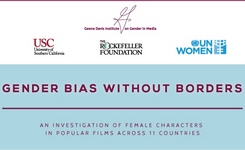
GENDER BIAS WITHOUT BORDERS
The purpose of this study was to examine the prevalence and nature of female characters in popular films from 11 countries around the world. One unifying theme was apparent: female characters are not equal and they are not aspirational in this sample of global films. This theme is illustrated by the following facts from this study
- Only 30.9% of all speaking characters are female.
• A few countries are better than the global norm: U.K. (37.9%), Brazil (37.1%), and Korea (35.9%). However, these percentages fall well below population norms of 50%.
• Two samples fall behind: U.S./U.K. hybrid films (23.6%) and Indian films (24.9%) show female characters in less than one-quarter of all speaking roles.
• Females are missing in action/adventure films. Just 23% of speaking characters in this genre are female.
• Out of a total of 1,452 filmmakers with an identifiable gender, 20.5% were female and 79.5% were male. Females comprised 7% of directors, 19.7% of writers, and 22.7% of producers across the sample.
• Films with a female director or female writer attached had significantly more girls and women on screen than did those without a female director or writer attached.
• Sexualization is the standard for female characters globally: girls and women are twice as likely as boys and men to be shown in sexually revealing clothing, partially or fully naked, thin, and five times as likely to be referenced as attractive. Films for younger audiences are less likely to sexualize females than are those films for older audiences.
• Teen females (13-20 years) are just as likely as young adult females (21-39 years) to be sexualized.
• Female characters only comprise 22.5% of the global film workforce, whereas male characters form 77.5%.
• Leadership positions pull male; only 13.9% of executives and just 9.5% of high-level politicians were women.
• Across prestigious professions, male characters outnumbered their female counterparts as attorneys and judges (13 to 1), professors (16 to 1), medical
Given these grim findings, a call to change is crucial. Girls and women comprise 50% of the world’s population, but represent far less of the international film populace. Asking filmmakers to create more roles for girls and women is not asking for the impossible. Instead, adding girls and women to stories means conceptualizing a fictional world that looks startlingly like the one we already inhabit.
Second, a call to be creative is necessary. Female characters can and should easily fill an equivalent share of the workforce and clout positions across industries simply through the imaginations of their creators. Conceiving of female CEOs, politicians, lawyers, judges, and doctors is the work of a creative writing moment but could have important and lasting consequences for the next generation.
Though the findings above are compelling, this study has a few limitations. First, the sample of films from each country was quite small. Analyzing ten movies does not summarize the full array of diversity that exists in each nation. Future research should examine more movies to determine if these initial trends are borne out.
Second, highly popular films for slightly older audiences were not included in order to achieve a “rough equivalency” to a MPAA rating of PG-13 or lower in our sample. This may mean that content with more girls and women or different portrayals of sexualization or occupation was not captured. Future scholars could expand the range of films they study to determine if films with higher ratings contain more or less gender stereotyping, or other problematic instances of gender relations (i.e., domestic violence). A deeper dive into animated or films targeted to children would also be instructive.
Third, the occupation measure we used privileged a U.S. definition of industries. This was chosen specifically to facilitate comparisons to our previous research. However, we may have missed slight cultural variability in how different jobs or sectors are regarded in each country. Relying on research assistants primarily from the countries sampled was one means of ensuring that any variation remained minimal.
Despite these limitations, the present study offers a unique glance at the gendered nature of film content worldwide. The opportunity to usher in a new reality is close at hand, however. Equipping and catalyzing storytellers to counter decades of stereotypical media portrayals is one place to start. After all, filmmakers make more than just movies, they make choices. Those choices could be for balance, for less sexualization, and for more powerful female roles. The choice could be for gender equality.
For the reading of the executive summary of the report, please visit the link :
https://seejane.org/wp-content/uploads/gender-bias-without-borders-executive-summary.pdf
(Published on October 23, 2017)// सोमबार, कार्तिक ६, २०७४ मा प्रकाशित

Leave a Reply